
Bricks without straw is a phrase that refers to a task which must be undertaken without appropriate resources.

Bricks without straw is a phrase that refers to a task which must be undertaken without appropriate resources.
In Exodus 5 (Parshat Shemot in the Torah), Moses and Aaron meet with the pharaoh and deliver God's message, "Let my people go". [1] The pharaoh not only refuses, but punishes the Israelites by telling his overseers, "Ye shall no more give the people straw to make brick, as heretofore: let them go and gather straw for themselves", but still requiring the same daily output of bricks as before. [2] The Israelites complain to Moses and Aaron that they have now made things worse for them, and Moses in turn complains to God that every time he has gone to the pharaoh on behalf of the Israelites, things have gotten worse for them. God replies to Moses that the time will come when the pharaoh himself will actually drive the Israelites out of Egypt; and that on behalf of his covenant with the Patriarchs, God will redeem the Israelites "with a strong hand and an outstretched arm", so that they will know him.
The scripture gives no account of Moses or Aaron replying directly to the Israelites regarding their complaint, but only of Moses' discussing it with God, and God's reply, which Moses conveys to the Israelites.
![Ancient Egyptian painted wooden model of three men making bricks], 12th Dynasty, 1991-1778 BCE, Beni Hasan tomb 275, British Museum Brick making model BM1.agr.jpg](http://upload.wikimedia.org/wikipedia/commons/thumb/c/c8/Brick_making_model_BM1.agr.jpg/220px-Brick_making_model_BM1.agr.jpg)

Many clay products require the addition of other materials to add strength and durability. In the case of bricks in Old Testament Egypt – river clay is usually composed of very fine particles and so would dry slowly – adding straw would "open up" the clay, allowing it to dry more readily in the sun. In addition to aiding in drying, the linear nature of straw adds stability to the clay brick in much the same way that rebar or wire mesh reinforce modern-day concrete. Bricks made without straw would break and crumble easily. Adobe bricks used around the world are generally only sun dried but grasses, straw and other materials are added to the clay for the same basic reasons. [3]
The ancient brick-making process can still be seen on Egyptian tomb paintings and models.
The phrase 'bricks without straw' appears in the Academy Award winning film The Ten Commandments (1956 film), when Ramses II (played by Yul Brynner) decrees that Moses "bear [his staff] before [his] idle people, and bid them [the Israelites] make brick without straw".

According to Abrahamic religions, Aaron was a prophet, a high priest, and the elder brother of Moses. Information about Aaron comes exclusively from religious texts such as the Hebrew Bible, the New Testament, and the Quran.
The Book of Exodus is the second book of the Bible. It is a narrative of the Exodus, the origin myth of the Israelites leaving slavery in Biblical Egypt through the strength of their deity named Yahweh, who according to the story chose them as his people. The Israelites then journey with the legendary prophet Moses to Mount Sinai, where Yahweh gives the 10 commandments and they enter into a covenant with Yahweh, who promises to make them a "holy nation, and a kingdom of priests" on condition of their faithfulness. He gives them their laws and instructions to build the Tabernacle, the means by which he will come from heaven and dwell with them and lead them in a holy war to conquer Canaan, which has earlier, according to the myth of Genesis, been promised to the "seed" of Abraham, the legendary patriarch of the Israelites.
"Go Down Moses" is an African American spiritual that describes the Hebrew exodus, specifically drawing from Exodus 5:1: "And the LORD spoke unto Moses, Go unto Pharaoh, and say unto him, Thus saith the LORD, Let my people go, that they may serve me", where God commands Moses to demand the release of the Israelites from bondage in Egypt. As is common in spirituals, the song discusses freedom, referring both to the freedom of the Israelites, and that of runaway enslaved people. As a result of these messages, this song was outlawed by many enslavers.
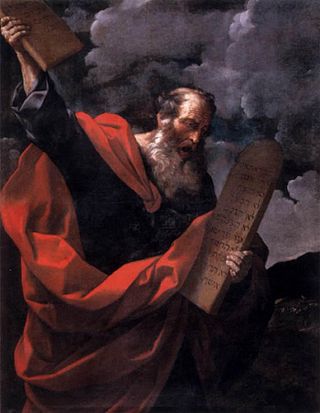
Moses was a Hebrew teacher and leader considered the most important prophet in Judaism and one of the most important prophets in Christianity, Islam, the Druze Faith, the Baháʼí Faith, Samaritanism, and Rastafariansim. According to both the Bible and the Quran, Moses was the leader of the Israelites and lawgiver to whom the prophetic authorship of the Torah is attributed.

The Crossing of the Red Sea or Parting of the Red Sea is an episode in the origin myth of The Exodus in the Hebrew Bible.

Miriam is described in the Hebrew Bible as the daughter of Amram and Jochebed, and the older sister of Moses and Aaron. She was a prophetess and first appears in the Book of Exodus.

The burning bush refers to an event recorded in the Jewish Torah. It is described in the third chapter of the Book of Exodus as having occurred on Mount Horeb. According to the biblical account, the bush was on fire but was not consumed by the flames, hence the name. In the biblical narrative, the burning bush is the location at which Moses was appointed by Yahweh to lead the Israelites out of Egypt and into Canaan.
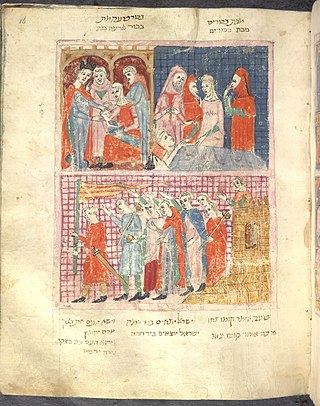
The Plagues of Egypt, in the account of the book of Exodus, are ten disasters inflicted on Biblical Egypt by the God of Israel in order to convince the Pharaoh to emancipate the enslaved Israelites, each of them confronting Pharaoh and one of his Egyptian gods; they serve as "signs and marvels" given by God to answer Pharaoh's taunt that he does not know Yahweh: "The Egyptians shall know that I am the LORD". The Ten Plagues are recited during the Passover Seder.
The Hebrew Bible is considered a holy text in most Abrahamic religions. It records a large number of events and laws that are endorsed or proscribed by the God of Israel. Judaism teaches that the Torah contains 613 commandments, many of which deal with crime and punishment, but only the Noahide Laws apply to humanity in general. Most Christian denominations have also adopted some of these directives, such as the Ten Commandments and Great Commandment, while a minority believes all Old Covenant laws have been abrogated.

The Exodus is the founding myth of the Israelites whose narrative is spread over four of the five books of the Pentateuch.
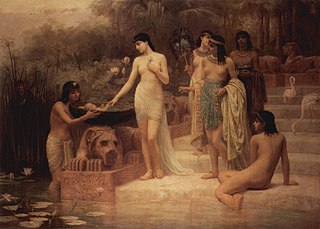
Shemot, Shemoth, or Shemos is the thirteenth weekly Torah portion in the annual Jewish cycle of Torah reading and the first in the Book of Exodus. It constitutes Exodus 1:1–6:1. The parashah tells of the Israelites' affliction in Egypt, the hiding and rescuing of the infant Moses, Moses in Midian, the calling of Moses, circumcision on the way, meeting the elders, and Moses before Pharaoh.
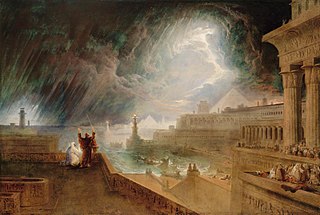
Va'eira, Va'era, or Vaera is the fourteenth weekly Torah portion in the annual Jewish cycle of Torah reading and the second in the Book of Exodus. It constitutes Exodus 6:2–9:35. The parashah tells of the first seven Plagues of Egypt.
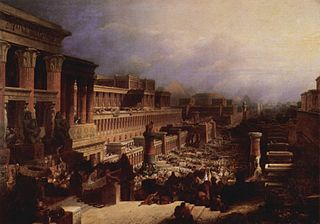
Bo is the fifteenth weekly Torah portion in the annual Jewish cycle of Torah reading and the third in the book of Exodus. The parashah constitutes Exodus 10:1–13:16. The parashah tells of the last three plagues on Egypt and the first Passover.

Beshalach, Beshallach, or Beshalah is the sixteenth weekly Torah portion in the annual Jewish cycle of Torah reading and the fourth in the Book of Exodus. It constitutes Exodus 13:17–17:16. In this parashah, Pharaoh changed his mind and chased after the Israelites, trapping them at the Sea of Reeds. God commanded Moses to split the sea, allowing the Israelites to escape, then closed the sea back upon the Egyptian army. The Israelites also experience the miracles of manna and clean water. And the Amalekites attacked, but the Israelites were victorious.
"With a strong hand and an outstretched arm" is a phrase used in the Bible to describe God's use of his power on behalf of Israel, particularly during the Exodus.

Discussions in rabbinic literature of the biblical character Moses, who led the Israelites out of Egypt and through their wanderings in the wilderness, contain various expansions, elaborations and inferences beyond what is presented in the text of the Bible itself.
The Quran contains references to more than fifty people and events also found in the Bible. While the stories told in each book are generally comparable, there are also some notable differences.
In the Exodus narrative, Yam Suph or Reed Sea, sometimes translated as Sea of Reeds, is the body of water which the Israelites crossed following their exodus from Egypt. The same phrase appears in over 20 other places in the Hebrew Bible. This has traditionally been interpreted as referring to the Red Sea, following the Greek Septuagint's rendering of the phrase. However the appropriate translation of the phrase remains a matter of dispute; as does the exact location referred to.
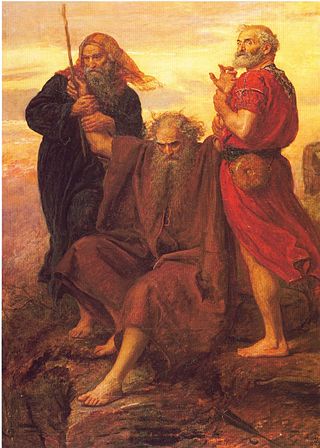
The Staff of Moses, also known as the Staff of God, is mentioned in the Bible and Quran as a walking stick used by Moses. According to the Book of Exodus, the staff was used to produce water from a rock, was transformed into a snake and back, and was used at the parting of the Red Sea. Whether the staff of Moses was the same as the staff used by his brother Aaron has been debated by rabbinical scholars.

"Finger of God" is a phrase used in the Torah, translated into the Christian Bible. In Exodus 8:16–20 it is used during the plagues of Egypt by Pharaoh's magicians. In Exodus 31:18 and Deuteronomy 9:10 it refers to the method by which the Ten Commandments were written on tablets of stone that were brought down from Mount Sinai by Moses.